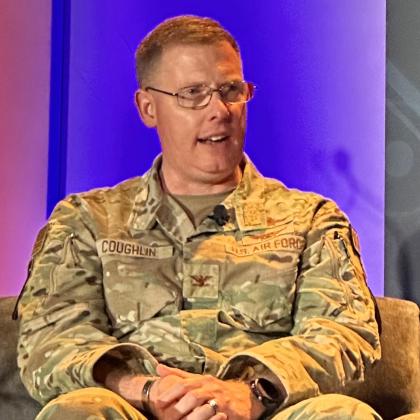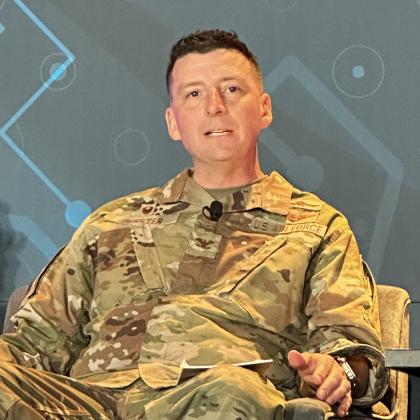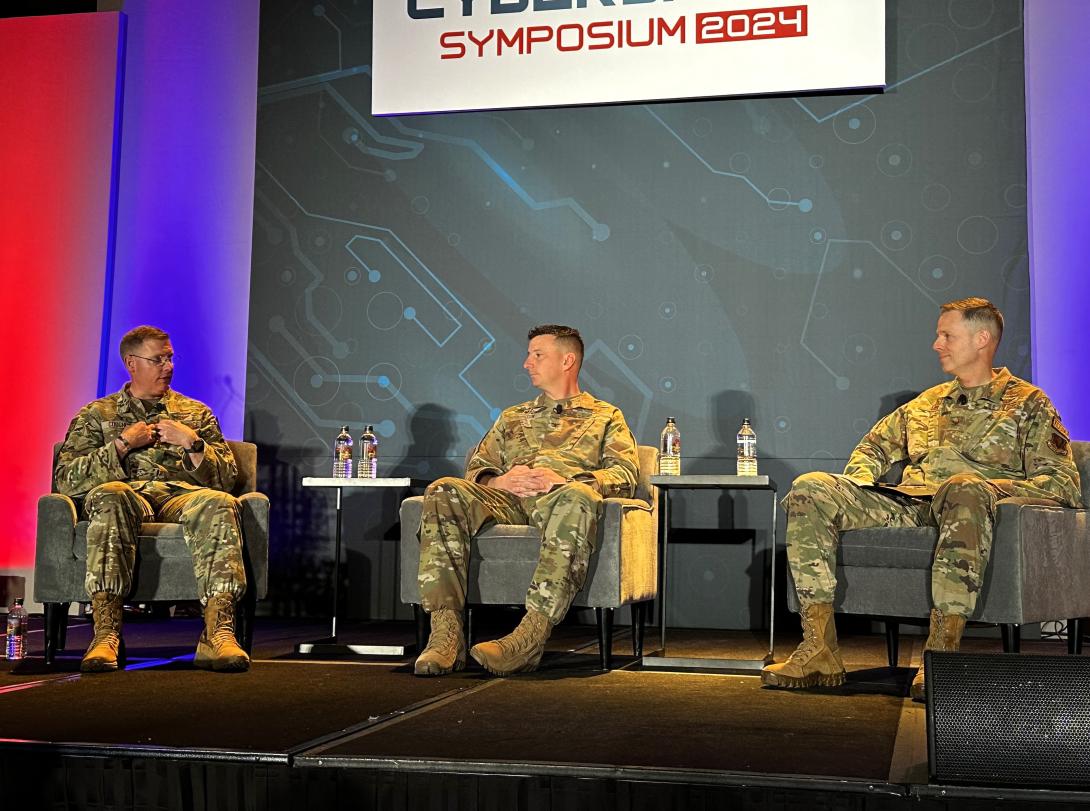Expeditionary Communications Lead the Way
The U.S. military’s reliance on warfighters providing expeditionary communications will only continue as the geopolitical environment shifts and the nation prepares further to address Great Power Competition.
The demand for the U.S. Air Force to send their so-called “XCOMMs,” or expeditionary communicators, to establish vital communications and data connections has XCOMMs positioned in Europe, Africa, the Middle East and elsewhere around the globe.
“Why is this important in a contested environment?” asked Col. James “Gumbo” Coughlin, director, Command, Control, Communications and Computer Systems (C4) Systems and chief information officer, HQ Joint Special Operations Command (JSOC), speaking on a panel of XCOMM leaders at the AFCEA Rocky Mountain Cyberspace Symposium in Colorado Springs, Colorado, on February 22.
“The reason being is if you can't move ‘101010s’ in a contested environment, we are not going to be value added as a force, as a cause for freedom. And so, for us as XCOMMs, as expeditionary communicators, our job is to enable command and control. Our job is to enable force projection. Our job is to do that ‘shoot, move and communicate,’ and be ready.”
The need for combat communications also comes at a time when the service is re-orienting itself to be able to provide air power and dominance in the face of Great Power Competition. “Our secretary is getting ready to re-posture, restructure the United States Air Force in a way that's never been done,” said Col. John “JJ” Riester, commander, 435th Air and Space Communications Group, Ramstein-Miesenbach Air Base, Germany. “It is the biggest organizational change since the inception of the Air Force.”
It is a challenge, the leaders said.
The XCOMM airmen face old technologies, budgetary constraints and great expectations to operate adroitly in remote, complex, degraded environments. And while not necessarily in conflict yet with the People’s Republic of China, the U.S. is certainly in “violent competition” with that adversary, the leaders said. Recent advisories warn how the PRC is positioning to wreak havoc on U.S. critical infrastructure through cyber vulnerabilities.
And with the rise of cybersecurity needs, the Air Force decreased investment in expeditionary communications over the last several years. The war on terror, with operations in the Middle East, in the U.S. Central Command (CENTCOM) area of responsibility, had a much more favorable atmosphere for setting up communications, so funds were turned to cyber, leaving the XCOMMs to now make do, despite operational demands.
“For the last two years, it has been a great challenge,” said Col. Riester who leads 600 airmen across three squadrons that provide U.S. Air Forces in Europe (USAFE) sole combat communications, specialized maintenance, and command and control , communications, computer, intelligence, surveillance and reconnaissance systems (C4ISR) support for NATO, U.S. European Command (EUCOM) and U.S. Africa Command.
“A lot of cannibalization of other legacy type of comm [communications] equipment that we've had to use, trying to piecemeal and put together with gum and duct tape, whatever it takes to be able to support the Eastern Flank,” the colonel said. “We have airmen scattered from the Baltics to the Balkans at 16 different sites, supporting supporting NATO operations with Ukraine. Several of them are as close as five kilometers to the adversaries’ border, and using yesterday's technology, using yesterday's way of thinking and yesterday’s tactics, techniques and practices.”

For us as XCOMMs, as expeditionary communicators, our job is to enable command and control. Our job is to enable force projection. Our job is to do that ‘shoot, move and communicate,’ and be ready.
The expeditionary communicators are getting a closer look at what operating in a degraded environment looks like, which is nothing like they experienced before in the CENTCOM area of responsibility (AOR), Col. Riester offered.
“The CENTCOM AOR, that was a 100-hour war,” he shared. “We had air superiority in 100 hours, which allowed us to mass our forces. And from a combat comm, XCOMM, perspective, in that continuum of where we were employed, traditionally we were at a ‘Phase Four, stabilize the environment, so we can mass’ perspective. I can tell you today, in EUCOM, Russia has a very sophisticated system. They have an A2AD [anti-access/area-denial] environment that is second to none. And it poses a lot of challenges for our XCOMM airmen and for our CFAC [combined force air component] and our theater.”
The leaders do see that the service’s move to reclassify Air Force specialty codes (AFSCs) to grow depth and capabilities and retain airmen in the cyber and the communications career fields is working, especially in regard to the so-called ‘Whiskey-Shredders,’ the W-X, Tactical Communication Professionals. The department condensed the number of AFSCs and separated out "shreds" of specialties.
“I think that ‘Whiskey-Shred’ for me, at least in the joint world makes it easier,” Col. Coughlin reflected. “If I am I going to put in place a Marine or a soldier, a sailor or airman in this formation, in that portion of our command, now I can go, ‘Oh, we’ve got a Whiskey-Shred person that I know probably comes with some exquisite training.”
“We absolutely love the ‘Whiskey-Shred.' ... A lot of thumbs up across the board within our community about that,” said Col. David Abel, commander 5th Combat Communications Group, Robins Air Force Base, Georgia. Known as the 5th MOB, the organization is the last remaining active-duty combat communications group, with more than 700 airmen, Guardians and other personnel.
Col. Abel explained that W-X was an idea that started with studies in 2015, which concluded that areas of the communications community had a lot of breadth but not enough depth in capabilities. He saw firsthand how some units did not have any expeditionary communications experience and did not know how to use the tactical equipment, and yet were still responsible for training and deploying, so it would take longer to prepare the units. And it would be a lot for the noncommissioned officers (NCOs) that had those skills because they then had to perform all of the training.
“It would really be tough on them, and it would be a retention issue for us,” he noted. And [without them] there was nobody left to train everybody else. What we are seeing with the Whiskies now, we are starting to build depth on our bench. We have more NCOs that are available to train the teams that we have. And as a result, our units are more resilient, more competent, more proficient.”
“With the ‘Whiskey-Shred,’ we are starting to really see the fruits of that, and it's been a game changer,” Col. Riester added. “It is keeping the talent in the family.”

I can tell you today, in EUCOM, Russia has a very sophisticated system. They have an A2AD [anti-access/area-denial] environment that is second to none. And it poses a lot of challenges for our XCOMM airmen and for our CFAC and our theater.
In addition, the leaders shared that the XCOMMs need to be more lethal and survivable, must evolve from being multicapable airmen and operate under the Agile Combat Employment construct and be ‘mission-ready,’ to meet the demands of the future operating environment.
“As XCOMM airmen, where do we find ourselves in this fight now?” Col. Riester asked. “Because we're not going to be able to mass. The Air Force’s and EUSAFE’s response to that is, ‘We're going to ACE[agile combat employment].’ We're going to do distributed operations, decentralized control. But C2, I would say, is the center of gravity for our force. How do we C2 those forces once we ACE?”
It is a more indeterminant environment. And for the past two years, the airmen in EUCOM have had to adjust. Instead of the XCOMM airmen traditionally setting up a main operating base, the warriors now “are in ‘a seize the initiative and dominate the battlespace’ environment, where no kidding, they are alone but unafraid. That's how we're retooling and reorienting ourselves to Great Power Competition,” explained the 435th commander.
In the special forces community, "mission ready" is part of the culture, Col. Coughlin stated. “As we transition from multicapable to mission-ready airmen, we live that life,” he said. “And the expectation of a ‘Whiskey-Shred’ and an XCOMM airman is that if you got to drive that 10k loader, you're driving it. If we need to put up a tent here, you are putting up the tent. Within my formation that I'm fortunate to serve in, it is just that. Every member of the JSOC enterprise has to be able to represent Communications JSOC any time on behalf of the National Mission Force and the SOCOM commander, but also be able to be that person to do that.”
Last May, Col. Abel hosted the XCOMM Roundup at Robins, bringing the community together to advance their ACE operations experience. Warfighters from seven different major commands, other services, joint forces and coalition partners trained, demonstrated capabilities, offered innovation and tested tactics, techniques and procedures to support the service’s Air Force Force Generation model (AFFORGEN).
One such innovation, featured by the 1st Air and Space Communications Operations Squadron (1st ACOS) stationed at Ramstein-Miesenbach Air Base, Germany, was a groundbreaking transport layer known as BlackNet. The ACOS warfighters have taken BlackNet from a network that just supports JWICS—the Joint Worldwide Intelligence Communications System—to supporting additional enclaves—such as SIPR, NIPR, special access or coalition.
Lastly, Col. Coughlin encouraged his fellow warfighters to apply to join the JSOC—especially as XCOMMs. He sees that the demands of the special forces do not necessarily bring in great numbers of airmen. “For me, as a member of a joint sub-unified command under SOCOM [U.S. Special Operations Command], I will tell you some of my biggest challenges are tied to talent,” he said. “It's important for me, as I look at our formation, when I'm fortunate to get people that make it through assessment and selection to go into our command, we get some of the best people that can apply.”
In whichever unit they serve, however, the role of the XCOMMs remains vital, especially going into Great Power Competition. “For anybody that wants to articulate that XCOMM isn't important, maybe we should look at the global landscape and think about competition,” said Col. Coughlin. “Because if you can't communicate, you're just camping ... and XCOMMs, you're certainly vital to our nation and vital to the progression of freedom across the globe.”






Comments